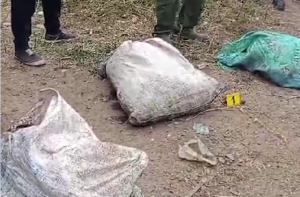China’s “Unrestricted Warfare” Against the US

The Chinese Communist Party, led by China’s President Xi Jinping, has, over the years, by espionage, intellectual property theft, hacking, spying and militarizing artificial islands, initiated a bitter conflict between China and the US.
China appears determined to “neutralize” states that might challenge its claim to the South and East China Seas. If successful, China’s naval assets will dominate a large portion of the world’s commercial sea lanes, if the US is unable — or unwilling — to knit together a serious formal military alliance of democratic states in the Indo-Pacific.
Rather than fight a war, China apparently is hoping to envelop the US in Latin America by establishing Chinese-controlled ports and numerous bilateral Belt and Road Initiative projects in Cuba, Panama, Venezuela, Nicaragua, Brazil and Argentina.
Is the US ready?
China is fully engaged in a multi-front war against the United States. This “unrestricted warfare” against America has several dimensions: technological, space, military, political, economic, digital, psychological, informational and diplomatic. In fact, the Chinese Communist Party (CCP) openly declared a “people’s war” against the US in a May 14, 2019 edition of the People’s Daily.
The CCP, led by Chinese President Xi Jinping, has, over the years, by espionage, intellectual property theft, hacking, spying and militarizing artificial islands, initiated a bitter conflict between China and the US.
CCP propaganda, however, claims that China is supposedly only responding to America’s instigation of a “new cold war” against the People’s Republic of China (PRC), depicted as a policy to “contain China’s rise.”
The two all-encompassing themes of the CCP’s offensive are China’s Global Security Initiative (GSI) and a Global Developmental Initiative (GDI).
The GSI was fully unveiled in the September 2022 meeting of the “Heads of State Council” of the Chinese-led Shanghai Cooperation Organisation, in Samarkand, Uzbekistan. Xi personally defined the GSI as a global alternative to “bloc politics” such as NATO.
China appears determined to “neutralize” states that might challenge its claim to the South and East China Seas. If successful, China’s naval assets will dominate a large portion of the world’s commercial sea lanes, if the US is unable — or unwilling — to knit together a serious formal military alliance of democratic states in the Indo-Pacific.
China’s proliferating ballistic missiles, tipped with nuclear warheads, appear intended as a checkmate deterrence against any sustained US-led effort to oppose a Chinese invasion of Taiwan. China already has a formidable array of weaponry based in its coastal provinces opposite Taiwan, to deter the US from engaging in armed conflict with China in the Western Pacific.
China also has more than 28,000 migrants who have illegally crossed the US southern border – many clean-cut men of military age, unaccompanied by family, who show up in groups. One cannot just leave China the way one leaves the US. It is difficult, therefore, not to suspect that these men have been sent by the CCP as sleeper cell saboteurs, waiting to inflict small but deadly strikes on American infrastructure, such as electric grids, airports, water reservoirs, communications towers, bridges, tunnels, shopping malls, apartment complexes, and so forth.
Recently a secret illegal laboratory, “filled with infectious agents, medical waste and hundreds of mice bioengineered ‘to catch and carry the COVID-19 virus,'” was discovered in Reedley California when a municipal code enforcement officer saw a garden hose attached to a “building presumed to be vacant”.
According to Reedley City Manager Nicole Zieba, “They never had a business license…. The city was completely unaware that they were… operating under the cover of night.”
The lab, it turned out, was owned by a fugitive, Jiabei Zhu, who has ties to the Chinese Communist Party.
China’s Belt and Road Initiative (BRI), now active in more than 155 countries, was created ostensibly toward accomplishing the UN’s Sustainable Development Goals, including ending poverty, establishing food security. In practice, the BRI is assuring education warfare against the West, as well as presumably helping developing nations cultivate acceptance for the Chinese Communist Party model of governance. Many of the BRI projects have turned out to be debt-traps: China lends a developing country funds for a Chinese-built infrastructure project; then, if the country is unable to repay the debt, China offers to accept instead a port, airbase, rare earth minerals or other assets in lieu of repayment.
China also appears determined to emerge as the world’s leader in critical emerging technologies. China already is leading in some of these military applicable technologies such as: hypersonic flight, electric batteries and radio-frequency communications. One report claims that China already maintains a lead over the US in 37 out of 44 critical technologies.
In March and August of 2020, China threatened to restrict exports of life-saving medicines to the US.
Chinese operatives have been digging up genetically modified seeds in the US Midwest, for transfer to China.
China’s war against the West also includes a massive effort to steal intellectual property from US and European research laboratories. This dimension of China’s war is run by the CPC’s United Front Work Department. The feel-good name of this CCP agency is the Chinese People’s Association of Friendship with Foreign Countries. Its purpose is to facilitate the transfer of vital technologies and expertise from the West to China by creating an atmosphere of cooperation. This CCP front group’s objective is to implement a global approach to acquire any defense-related data that might serve China’s goals.
Beijing’s intelligence collection activities include the “Thousand Talents Program,” which recruits American scientists by offering research grants to study in China, and by using Confucius Institutes on university campuses to recruit talented students. The Thousand Talents Program ostensibly demonstrates to faculty and impressionable students the superiority of Chinese culture and why it is praiseworthy to embrace China’s accomplishments. In reality, these CCP institutions seem, like TikTok, to be indoctrination devices, to program academics to denigrate America and support China,
An effort to close down Confucius Institutes in the US has apparently been ineffective: they simply changed their name and resumed operation. They are now also infiltrating children’s education, from high schools down to kindergarten.
A darker side of these all-out intelligence-collection operations involves attempts to coerce Chinese-American professionals to cooperate with the CCP by pressuring them to return to China or threatening their family members who still reside in China.
There are, of course, many documented cases of agents of the CCP offering Americans “financial incentives” in exchange for “access” to people, information or both, as Peter Schweizer details in his book, Red-Handed: How American Elites Get Rich Helping China Win.
Theft of intellectual property also includes all companies in China being legally obligated to have Community Party officials embedded in their workforces, including in joint ventures of Chinese companies with Western companies. Such joint ventures are also required to transfer to the Chinese “partner” any privately produced advances in critical technologies.
China’s theft of US technologies and co-opting of US human resources are also being aided by a vast network of digital hackers, described by FBI Director Christopher Wray as “a cyberespionage program so vast that it is bigger than all of its major competitors combined.”
The diplomatic and economic dimension of China’s total war strategy against the US involves establishing rival political and economic blocs such as BRICS (Brazil, Russia, India, China and South Africa). BRICS is designed to draw non-Western developing countries to align their economic futures with China’s politically authoritarian planned economy model as opposed to the West’s democratic free-market model. BRICS has recently expanded its membership, which now includes Argentina, Egypt, Ethiopia, Iran, Saydi Arabia, and the United Arab Emirates. China, the dominant voice in BRICS, projects a disingenuous benevolent image to its members as well as to the so-called “Global South,” especially to impoverished countries in Africa. The ultimate objective of China’s “Global South” strategy is to supplant Western economic and diplomatic dominance, and China is facilitating this goal by challenging the US dollar as the world’s reserve currency.
China’s face to neighboring states is even more threatening. Chinese diplomats display a coercive attitude toward the states of Southeast Asia with which China has conflicting territorial and maritime claims. This pattern of aggressive behavior is often referred to by critics as “wolf warrior diplomacy.”
For example, China has exhibited belligerent behavior toward Japan, Australia and the Philippines. The Philippine government has accused Chinese “maritime militia” ships of swarming the Philippine-claimed Scarborough Shoal.
In 2020, Chinese Coast Guard vessels rammed Vietnamese fishing boats in waters off the Paracel Islands.
China has also of blinded US pilots with lasers and buzzed US jets.
From ancient times, Chinese Emperors assumed that nearby states were tributary societies, using a China-centric pejoratively referred to as “nan yang,” (South Seas/Southeast Asia.) Vietnam, for instance, was once referred to as “Annam,” the implication being, pacified southern regions.
China’s ambitious space program is also geared to create — entirely separate from the US — a rival constellation of global positioning satellites, a space station, and — we are not making this up — claims to territory on the earth’s moon and ultimately on Mars. Beijing also appears poised to challenge the US in near-earth space by having launched an array of anti-satellite weapons with the capability of blinding America’s satellites used collect and transmit intelligence.
While the People’s Liberation Army’s Strategic Rocket Force is not yet on par with the US or Russian militaries in its quantity of Intercontinental Ballistic Missiles (ICBMs), in the South China and East China Seas, Beijing has recently upgraded its missile deployment with the DF-17 (Dong Feng) a hypersonic longer range missile. The CCP plans to produce and deploy hundreds more ICBMs capable of striking the US mainland.
Silos for China’s additional ICBMs are already under construction in northwest China at Hami in Xinjiang Province and near Yumen in Gansu Province. China’s growing ICBM nuclear warhead-equipped strategic rocket force appears to be intended as a checkmate deterrence against any sustained US-led effort to oppose a Chinese invasion of Taiwan. China already has a formidable array of weaponry based in Chinese coastal provinces opposite Taiwan, to deter the US from opposing an armed conflict with China in the Western Pacific.
China’s war against the US further embraces a prominent degree of deception. While US policy makers are gaming out strategies to limit China’s aggression in the Pacific, Beijing is pursuing a policy of encirclement of the US. The CCP’s overall gameplan resembles the Chinese game of “Go” where two opposing players attempt to surround each other. Unlike Chess, the winner conquers without seizing pieces; it triumphs by suffocating the adversary. Rather than fight a war, China apparently is hoping to envelop the US in Latin America by establishing Chinese-controlled ports and numerous bilateral Belt and Road bilateral projects in Cuba, Panama, Venezuela, Nicaragua, Brazil, and Argentina.
egretnewseditor@mail.com























